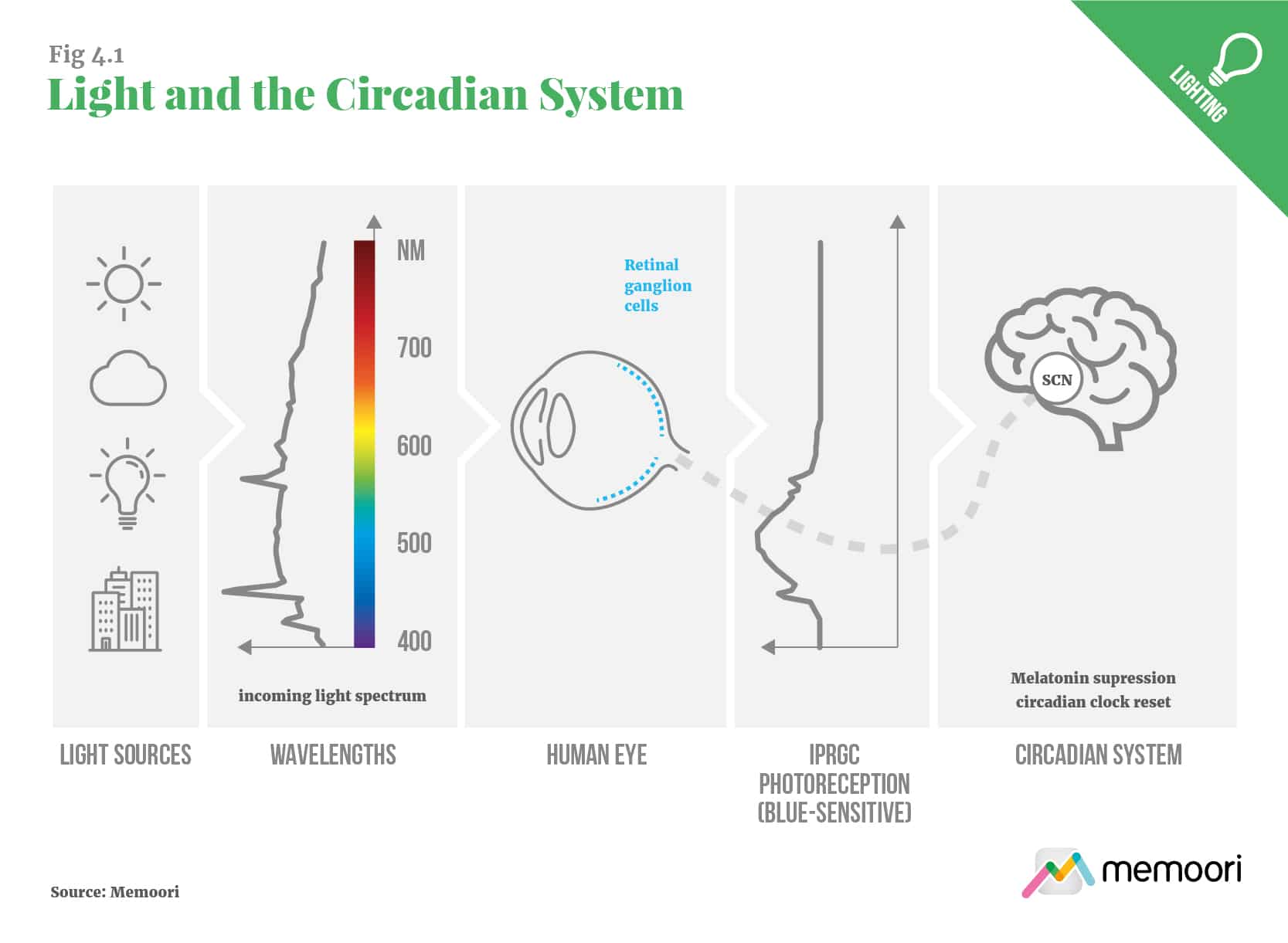Human-Centric Lighting (HCL) is illumination designed to trigger biological responses in humans to suit their activities and the overall objectives of a space. While mimicking the daily color and brightness output of natural sunlight provides a range of benefits for the user, there is more to HCL than simply replacing sunlight. Each space, depending on its users and its objectives, demands a slightly different pattern of light to maximize the benefits.
“While wavelengths that promote health and wellbeing may be desirable to most lighting spaces, others like productivity, restfulness, healing, or learning are better suited to some environments than others,” explains our latest report. “These differences allow HCL firms to design lighting systems to suit different spaces with different objectives. HCL applications have arisen in healthcare, offices, retail, hospitality, residential, and many more verticals, creating a confusing and fragmented market full of opportunity.”
The report The Human Centric Lighting Market 2019 to 2024: Global Market Prospects, Impacts & Opportunities estimates the value of the global HCL market at $849 million in 2019, and expects it to grow at a CAGR of 32.75% over the next 5 years. The ubiquity of light and the broad applications of HCL have led to interest from a wide range of building types. The report investigates 12 verticals, highlighting key projects and growth potential.
The research shows that healthcare is one of the most exciting markets for HCL. Above all, HCL offers health benefits in unnatural indoor environments. So, 24/7 illuminated environments where sick and injured people recover, such as hospitals, may be the most beneficial place for HCL technology. Moreover, healthcare facilities are already health-monitoring environments, meaning the benefits of HCL on patient outcomes can easily be tested and compared against historical data.
“Healthcare is likely to be a fast emerging vertical within the HCL market because is offers provable and tangible benefits,” says the comprehensive report. “The ability to quantify these benefits has a direct impact on the ability to raise funds for such lighting investments. Furthermore, HCL provides a low-cost high-value investment for facilities focused on the provision of health.”
Healthcare facilities are also workplaces and HCL is proving itself to be a powerful influence on employee health, wellbeing, and performance, with obvious knock-on benefits for patient outcomes. One study discovered that nurses who had access to natural light enjoyed significantly lower blood pressure, communicated more often with their colleagues, laughed more and served their patients in better moods than nurses who were exposed to large doses of artificial light.
The impact of HCL on workers is a common theme across all market verticals, none more so than in office buildings. The office is all about productivity, and the report demonstrates the results from early workplace installations that offer an undeniable case for the productivity-boosting abilities of human-centric office lighting. The paper explores a seven-month HCL trial in the Dutch offices of property company CBRE that experienced productivity gains of 18% against a control group.
“Offices like the CBRE headquarters in Amsterdam will no doubt expand their trials and deploy human-centric lighting technology across their facility,” the report forecasts. “There is also little doubt that these opportunities will be seized on by the lighting industry as long-awaited hard evidence that investment in dynamic lighting gives a tangible return. And if the evidence continues to grow, there is no doubt that human-centric lighting will become a common feature in the office.”

The implementation of HCL in educational settings has shown strong results for both the learning ability of students and the working performance of teachers. Much like healthcare, HCL’s success in education provides facilities with a low-cost option to meet their most important objectives. “By boosting education across the board, HCL could have long-term socio-economic implications for local areas and entire nations, and this is getting the attention of those who control education budgets,” the report says.
While exploring employee benefits, the retail industry is asking the question - can HCL make shoppers buy more? Retail outlets have long used light to draw attention to key products and guide shoppers around the store, but HCL provides the option for retailers to trigger biological responses in customers, maybe even put them in the right mood to shop. “HCL to trigger a “shopping mood” is somewhat controversial, but with the best sales enhancing results coming from HCL designed to make people more comfortable, and healthier, it seems unlikely to justify much resistance.”
HCL is being developed by the residential lighting sector to make people more comfortable at home, while hospitality wants it to create a comfortable home-away-from-home. The transport sector is using the technology to bring “natural” light to our indoor, and often underground, commutes. Human-centric light is not just for humans either, the same concepts can be applied to develop animal- and plant-centric-lighting for horticultural, agricultural, and zoological applications.
“Demand for HCL is driven by the growth of progressive buildings in a variety of verticals, within the wave of smart buildings that is beginning to dominate commercial real estate in economically mature markets,” says the brand new report. “As HCL reaches key adoption thresholds by demonstrating its ability to support human activity in each application, we expect to see rapid growth in those lighting verticals. As more verticals mature, HCL has the potential to become a standard approach to lighting in most buildings.”



